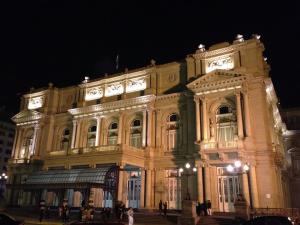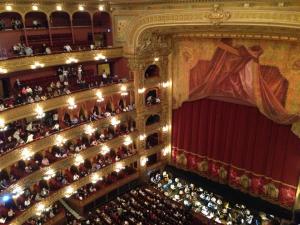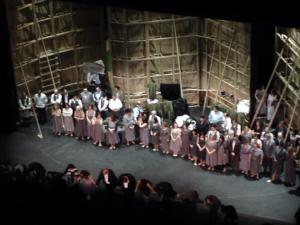The Teatro Colon. Not only an opera house, but a landmark full of over one hundred years of critically-acclaimed music, world-renowned architecture, and unparalleled history.
After originally opening in 1857, towards the end of the 19th century many people realized that the theater was in need of being re-built. So after a 20-year construction project, the theater that stands today was opened in 1908 with Giuseppe Verdi’s “Aida”. Flash forward through one hundred years of breath-taking performances by award-winning artists and some of the finest shows the world has ever seen, and once again in 2005, the theater was in need of a re-design. After five years of work and nearly $100 million committed to the project, the current theater re-opened in 2010 and is currently ranked the third best opera house in the world by National Geographic.
While pictures show the theater’s beauty, they still don’t do the Teatro Colon justice – after all, it is an opera house and needs to not only be seen, but also heard. If you’re in Buenos Aires and looking for a dose of culture, you can take a one-hour tour of the theater for $150 ARS (~$11 USD). While I’m sure the tour included many amazing facts and trivia (which I read about through the Teatro Colon website and Wikipedia), I decided to opt for something a little different instead – an actual performance.
As the universe would have it, I was fortunate enough to witness the opera of Giuseppe Verdi’s “Falstaff”, written by the same composer of the original performance that opened the theater over one hundred years ago. If you’re in Buenos Aires during the week, there should still be tickets available for daily performances in the upper seating levels around $80-150 ARS (~$6-11 USD). As I’m traveling on a budget I opted for the $80 ARS standing room only section, but now that I look back on it, I’d probably splurge the extra $50 ARS for a seat instead. Over an hour into the two and a half hour performance, my legs surprisingly weren’t as amused by the show as my ears were. Just a fair warning!
Being an Italian opera and displaying subtitles in Spanish, I will admit I was a little lost at first (and by “a little lost”, I mean “a lot lost”). But since the theater is acoustically regarded as one of the top five concert venues in the world, even though I didn’t understand what was going on most of the time, I still felt like I was experiencing something both culturally important and spectacular.
Tip: I recommend having a synopsis of whatever show you’re seeing pulled up on your phone so you can read what’s taking place in between curtain breaks. Trust me, it makes things a lot easier to understand.
As we all know, a night out at the opera is not everybody’s cup of tea. Some people say that enjoying opera is an acquired taste, much like a fine wine. However, if you’re fortunate enough to be in a city with one of the finest opera houses in the world and have a free night to kill, take a chance and let your soul absorb some of the finest culture and sounds that the Teatro Colon has to offer. You might not understand what the show is about, but music is a universal language that can always be appreciated with an open mind.









